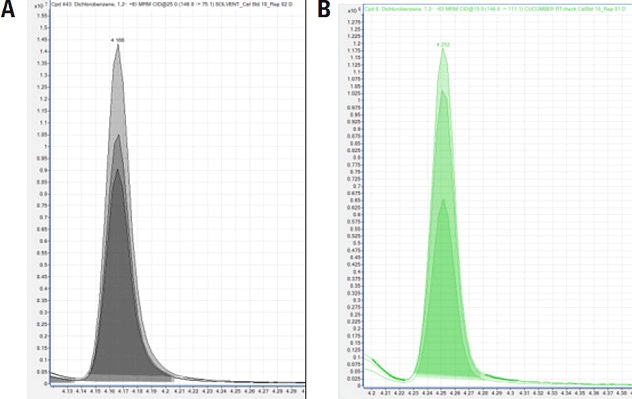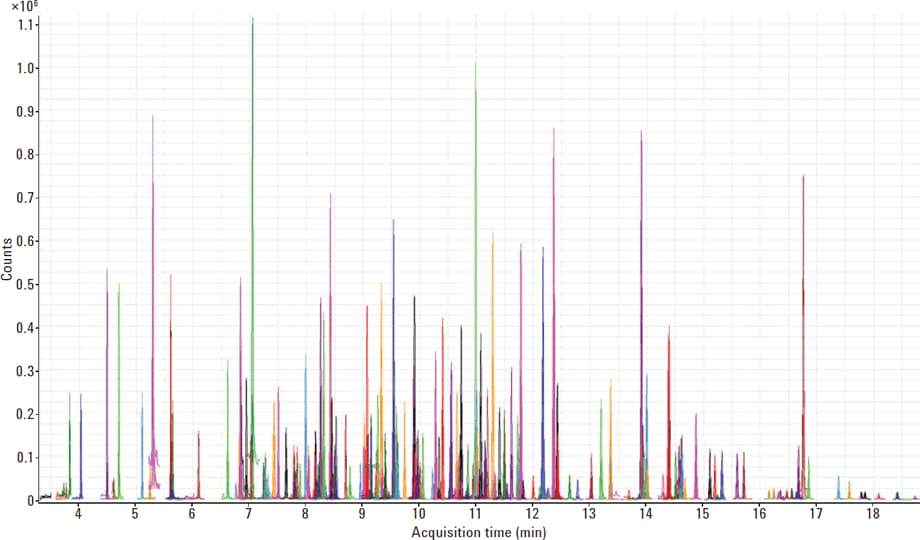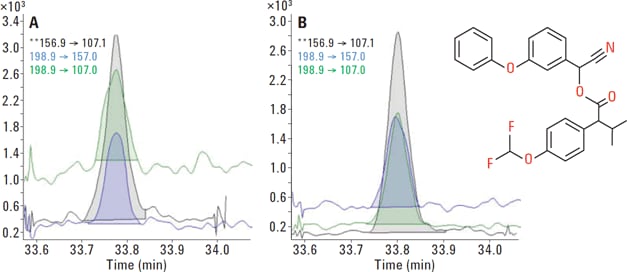Access Agilent eNewsletter January 2017

Preconfigured GC/MS/MS analyzer puts you on the fast track to pesticide analysis
Jessica Westland
Agilent Application Chemist
Ruben Garnica
Agilent Product Manager, GC/MS Analyzers
Concern about trace-level pollutants in food and the environment is driving the demand for rapid and reliable identification of chemical residues. To meet this challenge, you need technologies that can differentiate low ppb-level pesticides, polychlorinated biphenyls (PCBs), polycyclic aromatic hydrocarbons (PAHs), and other targets from organic interferences.
The Agilent Pesticides and Environmental Pollutants (P&EP) GC/MS/MS Analyzer 4.0 gives you the power to accurately confirm target pesticides while reducing the time required from start-up to results. It combines the leading-edge Agilent 7890B GC and 7000D/7010B Triple Quadrupole GC/MS systems with pretested methods and a comprehensive multiple reaction monitoring (MRM) pesticide database to provide exceptional results.
This valuable analyzer is preconfigured and the performance is tested at the factory and again in your lab. For dramatically improved pesticide analysis, you can take advantage of innovative technologies like Agilent JetClean self-cleaning ion source and dynamic MRM, which are available with this analyzer and any standalone Agilent GC/MS/MS.

Figure 1. Chromatograms of MRM transitions of 1,2-dichlorobenzene in ACN (A) and in cucumber (B). The best ions to monitor depend on the sample matrix.
Identify pesticides in multiple matrices with optimized MRM transitions
Matrix interferences have been a common challenge for MRM acquisitions in pesticides analysis because the selectivity of a given compound’s MRM transitions can change depending on the matrix interferences. To overcome this difficulty, Agilent offers the comprehensive Pesticides and Environmental Pollutants (P&EP) MRM Database. This MRM database contains 1,100+ compounds and up to 10 MRM transitions per compound. With a surplus of MRM transitions, you can monitor ions that avoid matrix interferences and confidently identify your target analytes.
To help you get started, Agilent scientists have analyzed 195 target compounds in a variety of matrices as well as in acetonitrile (ACN). The top five MRM transitions for each target compound in each of the matrices were selected based on response, ion ratios, and selectivity.
Figure 1 and Table 1 display just one example of ACN solvent-based MRMs compared with specific matrix-optimized MRMs. For many additional examples, see Agilent publication 5991-7303EN.
| Solvent MRMs | Cucumber MRMs | |||||
|---|---|---|---|---|---|---|
| Ion | m/z | Product | Collision energy | m/z | Product | Collision energy |
| Q0 (quant ion) | 148 | 75.1 | 25 | 146 | 75.1 | 25 |
| Q1 (qual ion) | 111 | 75.1 | 10 | 146 | 111.1 | 15 |
| Q2 (qual ion) | 146 | 75.1 | 25 | 111 | 75.1 | 10 |
Table 1. ACN solvent-based and matrix-optimized MRMs in cucumber for 1,2-dichlorobenzene.
The Agilent P&EP MRM database is the most comprehensive GC MRM database on the market. Not only does the Agilent P&EP Analyzer 4.0 come with the MRM database; but it also includes 7,800+ matrix-optimized transitions to provide you with your optimal pesticides analysis.
Accurately identify and quantify 195 pesticides in a 20-minute GC run
As sample complexity increases, using MassHunter Software with dynamic multiple reaction monitoring (dMRM) allows you to better tackle large multi-analyte analyses and accurately quantify trace levels of pesticides from high-throughput methods. Agilent publication 5991-7302EN shows the evaluation of both traditional time segment acquisition and dMRM acquisition methods. With a dMRM acquisition method, equivalent or better quality data and results are achieved from:

Figure 2. Successful 20 minute dMRM analysis of 195 target compounds in fresh leaf baby spinach uses three MRM transitions per compound.
- Monitoring MRM transitions based on the compounds’ retention times as they elute from the GC
- Reducing the number of MRM transitions that are active at any given time, allowing for longer dwell times
- Optimizing the dwell times to maintain a constant MS cycle time and sampling rate across all peaks
Figure 2 shows a chromatogram of the 195 target compounds in spinach. Dynamic MRM allows you to tackle complex, multi-analyte analyses in a high-throughput manner.

Figure 3. Example chromatograms for flucythrinate (in organic honey; at ~ 2.5 ppb) without Agilent JetClean (A) and with Agilent JetClean (continuous H2 flow at 0.13 mL/min) (B).
Maintain sensitivity and reproducibility with self-cleaning ion source
Food extracts are typically dirty samples that demand frequent MS ion source cleaning. The optional Agilent JetClean self-cleaning ion source reduces the time between manual source cleanings. Agilent publication 5991-7342EN describes how approximately 200 pesticides were analyzed in organic honey extract on the Agilent 7010A Triple Quadrupole GC/MS with and without the Agilent JetClean self-cleaning ion source. The chromatographic peak shape and baseline improved with the use of JetClean at 0.13 mL/min continuous H2 flow, particularly for the later eluting, higher molecular weight analytes (Figure 3).
Accelerate your pesticide analyses
If you need reliable pesticide analyses from the day your GC/MS/MS system is installed, discover more about the Agilent Pesticides and Environmental Pollutants (P&EP) Analyzer 4.0. Powered by market-leading triple quadrupole GC/MS technology, this factory configured, chemically tested analyzer puts you on the fast track to measure pesticides and other environmental pollutants in complex matrices.
Stay informed about the applications that are important to you
Subscribe to Access Agilent
Our free customized
monthly eNewsletter
Article Directory – January 2017
All articles in this issue
-
 Best practices for food safety laboratories: highlights from inaugural Agilent—AOAC workshop
Best practices for food safety laboratories: highlights from inaugural Agilent—AOAC workshop -
 ICP-MS and ICP-OES methodology enables comprehensive analysis and quantification of elemental extractables and leachables
ICP-MS and ICP-OES methodology enables comprehensive analysis and quantification of elemental extractables and leachables -
 Ask the Expert: Is there a simple, cost-effective alternative to traditional manual operation while improving precision in GC analysis?
Ask the Expert: Is there a simple, cost-effective alternative to traditional manual operation while improving precision in GC analysis? -
 Case study: Agilent customer collaboration delivers robust LC-QQQ method to quantify vitamin B12 absorption
Case study: Agilent customer collaboration delivers robust LC-QQQ method to quantify vitamin B12 absorption -
 Accelerate analysis of mineral oil (MOSH/MOAH) with ready-to-go online LC-GC/FID coupling
Accelerate analysis of mineral oil (MOSH/MOAH) with ready-to-go online LC-GC/FID coupling -
 Preconfigured GC/MS/MS analyzer puts you on the fast track to pesticide analysis
Preconfigured GC/MS/MS analyzer puts you on the fast track to pesticide analysis -
 Tip: Getting the best value from your UHPLC analyses
Tip: Getting the best value from your UHPLC analyses
Figure 1

Chromatograms of MRM transitions of 1,2-dichlorobenzene in ACN (A) and in cucumber (B). The best ions to monitor depend on the sample matrix.
Figure 2

Successful 20 minute dMRM analysis of 195 target compounds in fresh leaf baby spinach uses three MRM transitions per compound.
Figure 3

Example chromatograms for flucythrinate (in organic honey; at ~ 2.5 ppb) without Agilent JetClean (A) and with Agilent JetClean (continuous H2 flow at 0.13 mL/min) (B).